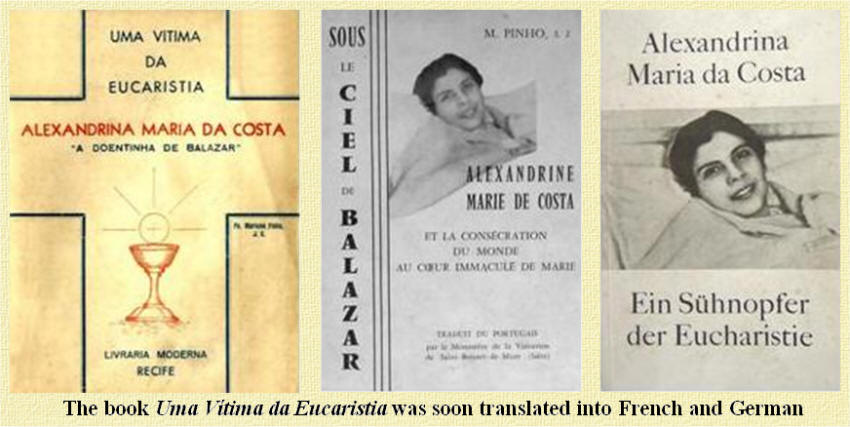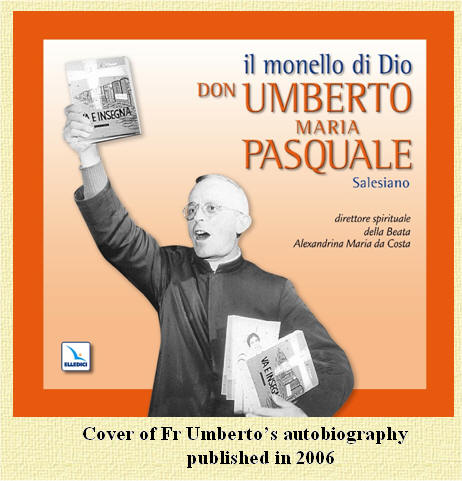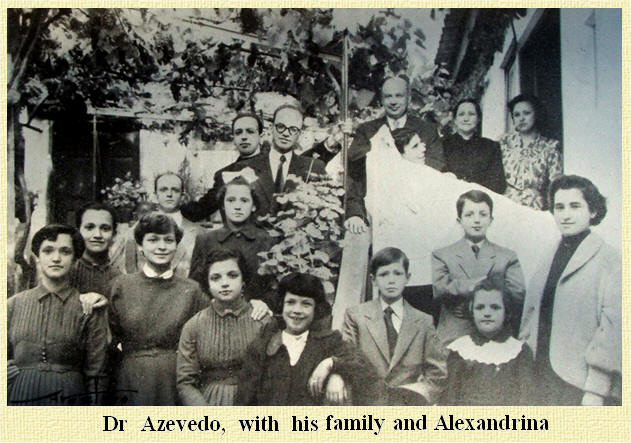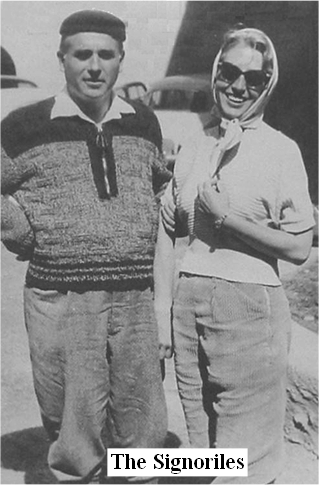![]()
THE PROMULGATION OF THE BLESSED ALEXANDRINA
|
The Bld Alexandrina has benefited from the enthusiasm of very devoted promoters. We want to mention the main ones here. 1. FR MARIANO PINHO
The
Jesuit Fr Marian Pinho (Oporto, 11.06.1894-Recife, Brazil,
11.07.1963), while he was in charge of the
Even the commission into the Consecration of the world to the Immaculate Heart of Mary had been conducted in such a way that, at the time, almost nobody was aware of Alexandrina’s role in its initiation. Jesus said that the departure of Fr Pinho for Brazil (in February 1946) was “the best way of his release”. Far removed from those who pursued him, he would be able to intensify his activities. Until 1953 he lived in the town Salvador da Baía, in Fr António Vieira College, and later in Recife, in Nóbrega College, dedicating himself to pastoral activity in the domain of Christian formation and the spiritual direction of laypeople. In terms of spreading the cult of Alexandrina, he wrote her first biography, Uma Vítima da Eucaristia (A Victim of the Eucharist), published, in 1956, only one year after her death; this book was translated into French in 1958, with the title Sous le Ciel de Balasar; later, in 1960, it was published in Switzerland in a German translation that ran to a second edition. Fr Mariano Pinho In 1963, when he died, Fr Pinho was still editing a new biography No Calvário de Balasar (On the Calvary of Balasar), which recently saw its first edition published in Portugal. It is a work that deserves the highest attention of the specialists.
At the request of Fr Umberto, the Signoriles corrected the many misprints of the Brazilian edition and translated it into Italian. Fr Pinho, who possessed a knowledge of Alexandrina that nobody could equal, acquired during the nine year in which he directed her, and from all the work involved in the process of realizing the Consecration of the world to the Immaculate Heart of Mary, had not read the thousands of pages of Feelings of the Soul, even if he kept some writings that Fr Umberto did not have the opportunity of referring to. Whether it was on account of the international success of A Victim of the Eucharist, or because of the promotion of Alexandrina’s cult in Brazil, where he was in contact with the Salesians (even in Recife), or for the acknowledged quality of On the Calvary of Balasar, he contributed extensively to the spread of the name of the soul he directed. This year, 2007, on 14th October, his mortal remains came back to Balasar. 2. FR UMBERTO PASQUALE
Fr
Umberto was born a century ago, in Vignole Borbera, near Turin,
Italy, on 1st
September 1906, and died in Rivoli,
When he arrived in Balasar in the summer of 1944 he was, at 38 years of age, already a man of experience. Ordained priest in Lisbon, in 1935, by the Cardinal Cerejeira, he opened a novitiate, Casa de Mogofores in Anadia, Aveiro, in 1937. By 1939 he had transformed it from a simple house for parochial activities into an oratory for male religious, a refuge for youngsters and a kindergarten. That none of this was easy, is attested by the fact that secular left opened fire against him. From the beginning he saw the written word as an important part of his apostolate so it was while he was in Mogofores that he launched the Salesian Editions which was to become prolific and influential under his direction. He himself wrote two sets of ten booklets for the enterprise. After 1944, Fr Umberto was always in contact, at least by letter, with the Beata of Balasar. When in 1948 he returned to Italy, he received her writings monthly. Therefore, he was able, as soon as she died, to promulgate her work and become her main exponent. The first work that he published about her was the biography Alexandrina in 1957. It is a long study of almost 400 pages. In 1965, when he initiated the preparation of the Process, he began the publication of a collection of her writings: issued then as Tu sei amore che tutto vince and Tu sei dolore che dà la vita. Then, at the end of the same Process, he edited in Italian Voleva chiudere l’Inferno, that had a Portuguese edition, in Balasar, in 1967, with the title Eis a Alexandrina (Here is Alexandrina). In 1973, he published, in Turin, in a non-commercial edition, a volume of 838 pages, the autobiography Cristo Gesù in Alexandrina. The first 600 pages contain Beata’s writings, and the remainder an important collection of documents. He also wrote various other books about the theme, but they were of minor importance.
Among Fr Umberto’s many readers, some deserve to be mentioned. One
such is the Salesian priest, A. Rebesco, an
Two remarkable Italian political leaders were devoted of Alexandrina, Giorgio La Pira and Oscar Luigi Scalfaro; there is no doubt that this devotion was the result of Fr Umberto’s writings. Another special example of disciples of this Salesian is the couple Eugénie and Chiaffredo Signorile, of whom we will speak in due place. Fr Umberto knew well the message of Fatima, as it is confirmed by his having received 166 letters from Sister Lucia. It is known that he wrote the books Fatima and Balasar and Eu Vi Nascer Fatima, but also wrote: Da Fatima un Messaggio di Salvezza, Francesco il Pastorello di Fatima, Giacinta la Pastorella di Fatima and La Madonna a Suor Lucia, besides others on diverse subjects. The centenary of his birth was marked in Turin by an appropriate commemoration, the publication of his beautiful autobiography, with the title Il Monello di Dio. The centenary did not also pass unobserved in Portugal either. 3. DR DIAS DE AZEVEDOAlexandrina’s doctor (the most important, because there were others) did not publish any book on her. But we are justified in mentioning him here for various reasons. He defended her, while still alive, from her detractors, and made important contributions to the respect in which her name was to be held, and even to its promotion. This he did in diverse ways, particularly in the letters he wrote to many persons, from the Archbishop, to the Pope, to the Provincial of the Jesuits (Fr Júlio Marinho), and to others, including Fr Pinho and Fr Umberto, and in the articles that he published in periodicals. After the death of his “godmother”, he wrote monthly bulletin about her for 14 years! If we link this with the 15 years during which he administered to her while she was still alive, we have about 30 years of uninterrupted devotion. A Speech It would require a book to register and to evaluate the extent of the work that the physician of Ribeirão (parish close to Balasar) dedicated to his “Godmother” and to make a collection of all that he wrote.
In this act of appreciation and homage to her, whom we called with affection The Little Patient of Balasar, I feel it my duty to say some words of nostalgia, congratulations and gratitude. Words of nostalgia, because the truth is that, with the elapse of time, our sadness for the loss of our loved Alexandrina, seems to become more acutely alive and the more so because we no longer hear her angelical voice advising us in our doubts, enlivening us in the fulfilment of our duty, in loving God more in out neighbour and, in a word, in living a worthier and more Christian life. And this nostalgia for Alexandrina can alone be alleviated in us by knowing that her sufferings as a victim for our sins and the sins of the world, towards her end, could not have been greater and that today she is enjoying, as the reward of her heroic virtue, that ultimate happiness, that St. Paul, in a sublime and unparalleled ecstasy, saw and later defined as being what “the eye has not seen, nor the ear heard, nor has it entered into the heart of man to conceive the joys God has prepared for those who love Him”. Words of congratulations. Yes, you deserve these congratulations for your sentiments and practical expressions, since Alexandrina’s death, and for the gift of the picture of her which has so embellished your church. Soon after her death, you showed your pain and your hope. Pain because you missed this extraordinary figure, the greatest glory of Balasar, a glory for all times, a glory that citizens of the future will say to belong to Portugal and to the entire world. You do not know, we do not know, what graces God created and accumulated in the part of this parish called Calvary, but, after some time has elapsed (without wanting to anticipate any definitive decision of the Church), it will be said that she was an extraordinary mystical soul, a propitiatory victim, one of those to whom Jesus referred when speaking to a religious sister in the following terms: “The celestial Father looks at them with special affability. They are the enchantment of the Angels and of men. They are very few. They are destined to serve as a defence in the face of the justice of the Heavenly Father, and to obtain mercy for the world”. You showed, ladies and gentlemen, your hope, because if Alexandrina’s funeral was an authentic glorification of her heroic and holy life, you would want that to signify your assurance of a valuable source of intercession for you in heaven. Yes, Alexandrina’s angelical smile is telling us that we can count on her and that we need not be discouraged in the tribulations of life. Our greatest poet has said that the “way of virtue” is “high and craggy, / but in the end, sweet, glad and delightful”[1]. For to attain Heaven there is only a way, that of duty, of repentance, of tribulations and crosses, and may Alexandrina’s life and smile stimulate us to follow it and to embrace it. Let us be sure of her intercession for us, before God, whom she adored so selflessly, and before the Immaculate Virgin, for whom she burned with love. Words of gratitude for you and your parish priest. The Rev. Abbot, during Alexandrina’s life, was untiring in giving her daily what she so desired, her beloved Jesus (her only food during thirteen and a half years) and who, since her death, has been untiring in revealing, by means of articles in the Press and preaching, the virtues of this heroic and angelical soul, that was our beloved and blessed Little Patient. May God give him many healthy years so that he may continue to teach us where the truth is and where the falsehood; so that he may continue to proclaim justice, because it is an act of justice to tell the world who Alexandrina was. And all of you, who in one way or another respect and cherish the memory of Alexandrina, be sure that she in Heaven and will not forget you and, grateful as she ever was, will make sure that you want for nothing. In your pains and joys ask for her intercession and, when her good offices are show fruit, continue by way of duty and gratitude, to give account of the graces received to the Rev. Abbot, to whom the ecclesiastical authorities have trusted the recording. At the end of the biography Alexandrina Fr Umberto alludes to the episode of the disclosure of the picture[2]. What he writes is worth reading: Six months after her death, during a solemn manifestation, the figure of Alexandrina smiled on all in the large picture that was inaugurated in the parochial hall of Balasar, as a signal of esteem and gratitude for how much she had done for her native land while still alive. According to Fr Francisco, the picture that is mentioned here is probably the one that today can be seen, much aged, above the bed, in her room. 4. THE SIGNORILESThe Signoriles are an Italian couple, Mathematics and Physics teachers at the Liceo Beccaria, in Milan, who made an intensive study of Bld Alexandrina. They collaborated with Fr Umberto Pasquale at the time of the Diocesan Informative Process, which took place in Braga between 1967 and 1973, translating the five thick volumes of Sentiments of the Soul.
Neither of them knew Alexandrina during her lifetime. a) Works published by the Signoriles with authorship attributed to Alexandrina: Figlia del dolore, madre di amore. Quasi una autobiografia, Mimep-Docete, Pessano (MI), 1993 (768 pages). Mio Signore, mio Dio! Come pregava Alexandrina, Mimep-Docete, Milan, 1992 (A Portuguese translation was published with the title Vida Interior da Beata Alexandrina, Apostolado da Oração, Braga, 2004, with authorship attributed to Eugénie and Chiaffredo Signorile). Maria, mia Madre. Come Alexandrina sente la Madonna, Mimep-Docete, Pessano (MI), 1987. Anima pura, cuore di fuoco, Mimep-Docete, Pessano (MI), 1990 (widely illustrated; it has been translated into English and Portuguese, but not published). Venite (richiami di Gesù), Mimep-Docete, Pessano (MI), 1991. Sofferenza amata, Mimep-Docete, Pessano (MI), 1999. Ho sete di voi, Mimep-Docete, Pessano (MI), 2004. Solo per Amore!, Mimep-Docete, Pessano (MI), 2006 (this book, conceived as an autobiography, has already translated into Portuguese and English; it is a highly thought of work). Zampilli Incandescenti, Mimep-Docete, Milan, 2007. b) Works published with authorship attributed the C.E. Signorile: Croce e sorriso, Associazione “Sotto il manto di Maria Regina della Pace”, Gorgonzola (MI), 2002 (there is Portuguese translation with the heading Sorrindo à dor, Cavaleiro da Imaculada, Oporto, 2001, with authorship attributed to Alexandrina Maria da Costa). Sulle ali del dolore, Gamba Edizioni, Gorgonzola (MI), 2004. Alexandrina, voglio imparare da te, Gamba Edizioni, Gorgonzola (MI), 2004 (this work, conceived as a vade-mecum for Alexandrina’s friends, is translated into Portuguese; in the Monthly Page of the Official Website it is also translated into Spanish, English, French and still, in part, in German and Slovene). c) Work published in collaboration with Giulio Giacometti and Piero Sessa: La Gloria dell'Uomo dei Dolori nel sorriso di Alexandrina, Edizioni Segno, Tavagnacco (UD), 2005. 5. THE “ALEXANDRINA SOCIETY”The English-speaking world knows Alexandrina for the most part through the book of Francis Johnston, Alexandrina: the Agony and the Glory. But the founder of the Alexandrina Society was an Irishman, also a layman, Francis Reynolds. The association was created in 1993. According to Jocie McEvoy, a lady who is passionate about Alexandrina and an active member of the Alexandrina Society, 30 people attended the first meeting of the Society which now has 1.000 or more members. They are not all active, but there exists an enthusiastic “hard core”, which never loses a chance to make Alexandrina known. There are members from all over Ireland, a good number in Great Britain and a strong branch in Scotland. There are also members in Australia, East Timor, Philippines, Singapore, Kenya, Portugal, Canada and United States. A quarterly bulletin is sent to associates. Here follows, from a dossier sent by Jocie McEvoy, the first page of a speech which Francis Reynolds once delivered on the subject “Alexandrina and the Importance of the Holy Eucharistic in Our Lives”: In 1992 it was my privilege to be given a mission by the Holy Sprit, to make known to the world the wonderful spiritual life of an extraordinary woman, Alexandrina da Costa, and her great love and union with God, to whom she offered her life of suffering for the conversion of sinners[3]. It seemed a gigantic mission, but God didn’t leave me on my own. He sent some wonderful people to join me, and with their help people all over the world are gradually getting to hear the name and learn of the life of Alexandrina Maria da Costa. For those who are not familiar with her life I will give you a few facts to put you in the picture. Alexandrina was born in Portugal in 1904 and lived there until her death in 1955. When she was a young girl some men tried to molest her, and, to safeguard her purity, she jumped from an upstairs window damaging her spine; this led to her being paralyzed for the last thirty years of her life. Although paralysed, Alexandrina would arise from her bed and suffer the Passion of Our Lord, from the Agony in the Garden to the Death on the Cross, with visible signs of suffering, as Jesus did, and in such a vivid manner that it always brought tears to the eyes of all who watched. This took place on Friday between 12 noon and 3 p.m. After each passion she would return to her paralysed state. This continued for three and a half years, and was always witnessed by others. Alexandrina lived for thirteen and a half years on the Holy Eucharist. Nothing else passed her lips during all that time and she still remained unchanged in appearance with no loss of weight nor loss of control of her senses. During these times many people called upon Alexandrina asking for prayers and cures of all kinds; they were always very interested in the many visions she had of Jesus and Mary and all wanted to know how to save their souls. Alexandrina who offered her life of suffering for the conversion of sinners would tell them of the importance of the Holy Eucharist in their lives and of the Real Presence of Jesus in the Eucharist. I’m sure Alexandrina met many people, as we all do, who believe the Eucharist is just symbolic; but I’m just as sure that when they left Alexandrina’s room there was no doubt in their minds about Christ’s presence in the Eucharist and how Jesus is the real friend who never abandons us. He knows each one of us personally. He knows our names. We can speak and confide in Him. He participates in our joys and consoles us in our grief and sadness. We should receive Jesus in the Eucharist often, abide in Him, let ourselves be guided and transformed by Him. Francis Reynolds, who was confined to bed for some years, died on 4th September 2006. Jocie McEvoy sent a brief biography of him from which these lines are quoted: “Francis had a tape made explaining how he came to know about Alexandrina. Not being able to write to everyone he took to phoning. Long distance calls never deterred him. Once he rang a lady member in Sri Lanka, her husband answered the phone and sounded angry – and no wonder, it was 4.00am there!” 6. OTHER PROMOTERSIn Italy In terms of Alexandrina’s studies, Italy leads the field. Until recently it was only there that scholars worked on her writings. Books, articles, leaflets and even pieces of art, such as a recent and very beautiful icon, have been numerous. At present, the most active promoters are the teachers Eugénie Signorile and Maria Rita Scrimieri, and the Salesian, Fr Pier Luigi Cameroni. Two recent booklets in English Into the space of about a year two booklets on Bld. Alexandrina were published in English. Their authors, Leo Madigan (born in New Zealand, but for many years resident in England, and today in Fatima) and Kevin Rowles (who lives in England), are both people well placed to promote their works. Both are in frequent contact with Balasar, Kevin Rowles having already been used as a source of information for the Official Website in his Blessed Alexandrina Maria da Costa, living Miracle of the Eucharist. Leo Madigan’s book is entitled Bl. Alexandrina Maria da Costa, the Mystical Martyr of Fatima. In the Americas Fr. Pinho was the first to promote Alexandrina in Latin America, as we have seen; but today she is not only known in Brazil but also in many other South American countries. In Argentina a well-known hagiographer, the Franciscan Contardo Miglioranza, published a biography of her. But it is the Salesians who have made her known in Chile, Bolivia, Peru, etc. Furthermore, in Central America she is not ignored, because from Panama to Nicaragua and largely in Mexico, the Salesian co-operator Yolanda Astrid has spread her name[4]. In North America, where Francis Johnston’s book had a second edition, the name today is promoted largely by the website of the Siervas de los Corazones Traspasados de Jesus y de Maria, of Miami. But there exist some isolated activists in her cause. There is even an American bishop who regularly brings a pilgrimage to Balasar. In Canada, too, she is not unknown. Balasar
Balasar had and has a special role in the promotion of Alexandrina. It all started there. While she was still alive her house was the object of great pilgrimage and it continues to be so today, as does her tomb. In Balasar was published, and continues to be published, Alexandrina’s Bulletin. Also many books on Aleandrina are sold there, mostly Salesian edition (of the Edições Salesianas and of the Cavaleiro da Imaculada). Some publications have been promoted there but above all the most important things in the house are Alexandrina’s manuscripts and relics. The Official Website For years, internet pages on Alexandrina have multiplied. Two years ago however, with the creation of the Official Website (http://alexandrinabalasar.free.fr/), the trend seems to stabilize. On the site there are sections for different languages: about two sets of ten books can be found there in Portuguese, Italian, Spanish, French and English. Lesser texts still exist in German, in Polish, in Slovene, even in Norwegian, in Japanese and in Chinese. The list of collaborators is great, with the Italians and the Portuguese predominating; but Alfonso Rocha has also translated much into French and Leo Madigan into English. A second indispensable instrument for Alexandrina’s promulgation is her bulletin, whose publication was recently returned to Balasar.
[1]
Luís de Camões, Os Lusíadas, canto IX, strophe 90. |
![]()

 Alexandrina’s
direction, acted with the greatest discretion. He considered it
important that Alexandrina’s cult develop of itself, without
advertising; it would happen in its own pace. But at this time,
against his will and that of Alexandrina, she gained significant
notoriety with the publication of Fr Terças’ article. This notoriety
expanded in 1944, shortly before the arrival of Fr Umberto, when the
Archdiocese took its position of publicly confronting the Patient of
Calvary.
Alexandrina’s
direction, acted with the greatest discretion. He considered it
important that Alexandrina’s cult develop of itself, without
advertising; it would happen in its own pace. But at this time,
against his will and that of Alexandrina, she gained significant
notoriety with the publication of Fr Terças’ article. This notoriety
expanded in 1944, shortly before the arrival of Fr Umberto, when the
Archdiocese took its position of publicly confronting the Patient of
Calvary. 
 Turin,
in
Turin,
in  Italian, who
wrote L' Estatica, and which was translated into the Thai
language. Another is an English layman Francis Johnston, author of
the book Alexandrina the Agony and the Glory that made the
name of the Patient of Balasar known in the English- speaking world.
Italian, who
wrote L' Estatica, and which was translated into the Thai
language. Another is an English layman Francis Johnston, author of
the book Alexandrina the Agony and the Glory that made the
name of the Patient of Balasar known in the English- speaking world. Let
us listen to this speech, transcribed from the periodical Ala-Arriba
(7/4/56) which Dr Azevedo gave in Balasar, on 28/1/56, and to
the picture that he paints of Alexandrina:
Let
us listen to this speech, transcribed from the periodical Ala-Arriba
(7/4/56) which Dr Azevedo gave in Balasar, on 28/1/56, and to
the picture that he paints of Alexandrina:  Professor
Chiaffredo, born
Professor
Chiaffredo, born 
